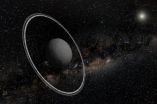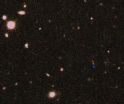(Press-News.org) Working with genetically engineered mice, Johns Hopkins neuroscientists report they have identified what they believe is the cause of the vast disintegration of a part of the brain called the corpus striatum in rodents and people with Huntington's disease: loss of the ability to make the amino acid cysteine. They also found that disease progression slowed in mice that were fed a diet rich in cysteine, which is found in foods such as wheat germ and whey protein.
Their results suggest further investigation into cysteine supplementation as a candidate therapeutic in people with the disease.
Up to 90 percent of the human corpus striatum, a brain structure that moderates mood, movement and cognition, degenerates in people with Huntington's disease, a condition marked by widespread motor and intellectual disability. And while the genetic mutation underlying Huntington's disease has long been known, the precise cause of that degeneration has remained a mystery.
In a report on their discovery in the advanced online publication of Nature on March 26, the Johns Hopkins researchers, led by Solomon Snyder, M.D., tracked the degenerative process to the absence of an enzyme, cystathionine gamma lyase, or CSE.
"Usually it's very hard, if not impossible, to develop straightforward mechanisms that explain what's going on in a disease. What's even harder is even if you can find a mechanism that causes a tissue to rot, usually there's nothing you can do about it," says Snyder, a professor of neuroscience at the Johns Hopkins University School of Medicine. "In this case, there is."
Huntington's disease, an inherited disorder, does its damage because of abnormal DNA coding for the amino acid glutamine. Healthy individuals have some 15 to 20 DNA "repeats" in that part of their genetic code, while Huntington's disease gene carriers have more than 36 — and often upward of 100. Children born to a parent carrier have a 50/50 chance of inheriting the disorder, and the greater the number of repeats, the earlier the age of onset of the incurable disorder.
Bindu Diana Paul, Ph.D., a molecular neuroscientist and faculty instructor in Snyder's laboratory, was studying mice lacking CSE, which helps make the amino acid cysteine and hydrogen sulfide that moderate blood pressure and heart function. Paul, who had previous research experience with Huntington's disease, says she was startled to observe that her mutant mice also behaved a lot like those with the disease.
When a normal mouse is dangled upside down from its tail, it will twist and turn and try to bite the offending hand, she explains. But her CSE-knockout mice stayed relatively still and clasped their paws together — the same behavior she'd observed in mice with the rodent equivalent of Huntington's disease. "It looked like there was a neurological deficit," Paul says. "But nobody had looked at CSE in the brain."
Paul and Snyder began monitoring CSE in mouse and human brain tissues and found considerably less CSE in all diseased tissues. All people carry some normal huntingtin protein made by the Huntington's disease gene, although the protein's function remains elusive. But people with Huntington's disease also carry mutant huntingtin proteins. Snyder and his team saw that the mutant proteins were attaching themselves to a crucial protein responsible for turning the CSE gene on or off, which ultimately led the diseased rodent and human brain tissues to be deprived of cysteine.
To see if loss of cysteine was directly responsible for the symptoms associated with Huntington's disease, the Johns Hopkins team turned to readily available sources of the substance in everyday foods and fed mice a cysteine-rich diet.
The results, Paul says, were striking. When those mice were dangled from their tails, they resumed struggling, although with a bit less vigor than their healthy peers. They were able to grip an object with greater strength, and they took longer to fall off a balancing apparatus than CSE-knockout mice. Their life expectancies increased one to two weeks.
Snyder and Paul say they are cautiously optimistic about the results, noting that although they suggest a possible treatment for Huntington's disease, it's clear that a high cysteine diet merely slows rather than halts the progression of the disease. Moreover, the results in live mice may not occur in humans.
INFORMATION:
Additional authors include Juan Sbodio, Risheng Xu, M. Scott Vandiver, Jiyoung Cha and Adele Snowman, all from the Johns Hopkins University School of Medicine.
This work was supported by the United States Public Health Service (grant MH18501) and the Cure Huntington's Disease Initiative.
Brain degeneration in Huntington's disease caused by amino acid deficiency
In mice, dietary changes slow down progression of the disease
2014-03-26
ELSE PRESS RELEASES FROM THIS DATE:
Cosmic collision creates mini-planet with rings
2014-03-26
Until now, rings of material in a disc have only been observed around giant planets like Jupiter, Uranus, Neptune and especially Saturn, which is known for its spectacular rings. Now astronomers from the Niels Bohr Institute, among others, have observed the first miniature planet with two rings of ice and pebbles. It is a smaller celestial body, called Chariklo, located two billion kilometers out in the solar system between Saturn and Uranus. The results are published in the prestigious scientific journal, Nature.
Chariklo was located in the Kuiper Belt, a collection ...
New maps for navigating the genome unveiled by scientists
2014-03-26
Scientists have built the clearest picture yet of how our genetic material is regulated in order to make the human body work.
They have mapped how a network of switches, built into our DNA, controls where and when our genes are turned on and off.
University of Edinburgh scientists played a leading role in the international project – called FANTOM5 – which has been examining how our genome holds the code for creating the fantastic diversity of cell types that make up a human.
The three year project, steered by the RIKEN Center for Life Science Technologies in Japan, ...
Keeping secrets in a world of spies and mistrust
2014-03-26
VIDEO:
This is an interview with Professor Artur Ekert, co-inventor of quantum cryptography, about what it takes to keep secrets secret.
Click here for more information.
Revelations of the extent of government surveillance have thrown a spotlight on the security – or lack thereof – of our digital communications. Even today's encrypted data is vulnerable to technological progress. What privacy is ultimately possible? In the 27 March issue of Nature, the weekly international ...
Cell-saving drugs could reduce brain damage after stroke
2014-03-26
Long-term brain damage caused by stroke could be reduced by saving cells called pericytes that control blood flow in capillaries, reports a new study led by scientists from UCL (University College London).
Until now, many scientists believed that blood flow within the brain was solely controlled by changes in the diameter of arterioles, blood vessels that branch out from arteries into smaller capillaries. The latest research reveals that the brain's blood supply is in fact chiefly controlled by the narrowing or widening of capillaries as pericytes tighten or loosen around ...
Should whole-genome sequencing become part of newborn screening?
2014-03-26
That question is likely to stir debate in coming years in many of the more-than-60 countries that provide newborn screening, as whole-genome sequencing (WGS) becomes increasingly affordable and reliable. Newborn screening programs – which involve drawing a few drops of blood from a newborn's heel – have been in place since the late 1960s, and are credited with having saved thousands of lives by identifying certain genetic, endocrine or metabolic disorders that can be treated effectively when caught early enough. Advocates of routine WGS for newborns argue that the new technology ...
Solar System's edge redefined
2014-03-26
Washington, D.C.—The Solar System has a new most-distant member, bringing its outer frontier into focus.
New work from Carnegie's Scott Sheppard and Chadwick Trujillo of the Gemini Observatory reports the discovery of a distant dwarf planet, called 2012 VP113, which was found beyond the known edge of the Solar System. This is likely one of thousands of distant objects that are thought to form the so-called inner Oort cloud. What's more, their work indicates the potential presence of an enormous planet, perhaps up to 10 times the size of Earth, not yet seen, but possibly ...
Penn Dental Medicine-NIH team reverses bone loss in immune disorder
2014-03-26
Patients with leukocyte adhesion deficiency, or LAD, suffer from frequent bacterial infections, including the severe gum disease known as periodontitis. These patients often lose their teeth early in life.
New research by University of Pennsylvania School of Dental Medicine researchers, teaming with investigators from the National Institutes of Health, has demonstrated a method of reversing this bone loss and inflammation.
The work was led by Penn Dental Medicine's George Hajishengallis, professor in the Department of Microbiology, in collaboration with Niki Moutsopoulos ...
Researchers present comprehensive 'roadmap' of blood cells
2014-03-26
(WASHINGTON, March 26, 2014) – Research published online today in Blood, the Journal of the American Society of Hematology, presents an unprecedented look at five unique blood cells in the human body, pinpointing the location of key genetic regulators in these cells and providing a new tool that may help scientists to identify how blood cells form and shed light on the etiology of blood diseases.
Work published today in Blood* is a subset of a much larger catalog of genetic information about nearly 1,000 human cells and tissues unveiled today from the international research ...
3-D MRI scans may offer better way to predict survival after chemo for liver tumors
2014-03-26
In a series of studies involving 140 American men and women with liver tumors, researchers at Johns Hopkins have used specialized 3-D MRI scans to precisely measure living and dying tumor tissue to quickly show whether highly toxic chemotherapy – delivered directly through a tumor's blood supply – is working.
The investigators say their findings, to be presented March 22-27 in San Diego at the annual meeting of the Society of Interventional Radiology, are the first "proof of principle" that this technology can show tumors in three dimensions and accurately measure tumor ...
Lawrence Livermore scientists discover bacterial resistance to improve biofuel production
2014-03-26
Resistance is not futile when it comes to a new method to more efficiently convert biomass to biofuels.
New research by scientists from Lawrence Livermore National Laboratory in conjunction with the Joint BioEnergy Institute (JBEI) suggests that a type of bacterial resistance may provide more efficient production of biofuels.
The team identified the genetic origin of bacterial resistance to an ionic liquid (a salt in the liquid state), which they successfully introduced into a strain of E. coli bacteria for the production of advanced biofuels. The ionic liquid resistance ...
LAST 30 PRESS RELEASES:
Numbers in our sights affect how we perceive space
SIMJ announces global collaborative book project in commemoration of its 75th anniversary
Air pollution exposure and birth weight
Obstructive sleep apnea risk and mental health conditions among older adults
How talking slows eye movements behind the wheel
The Ceramic Society of Japan’s Oxoate Ceramics Research Association launches new international book project
Heart-brain connection: international study reveals the role of the vagus nerve in keeping the heart young
Researchers identify Rb1 as a predictive biomarker for a new therapeutic strategy in some breast cancers
Survey reveals ethical gaps slowing AI adoption in pediatric surgery
Stimulant ADHD medications work differently than thought
AI overestimates how smart people are, according to HSE economists
HSE researchers create genome-wide map of quadruplexes
Scientists boost cell "powerhouses" to burn more calories
Automatic label checking: The missing step in making reliable medical AI
Low daily alcohol intake linked to 50% heightened mouth cancer risk in India
American Meteorological Society announces Rick Spinrad as 2026 President-Elect
Biomass-based carbon capture spotlighted in newly released global climate webinar recording
Illuminating invisible nano pollutants: advanced bioimaging tracks the full journey of emerging nanoscale contaminants in living systems
How does age affect recovery from spinal cord injury?
Novel AI tool offers prognosis for patients with head and neck cancer
Fathers’ microplastic exposure tied to their children’s metabolic problems
Research validates laboratory model for studying high-grade serous ovarian cancer
SIR 2026 delivers transformative breakthroughs in minimally invasive medicine to improve patient care
Stem Cell Reports most downloaded papers of 2025 highlight the breadth and impact of stem cell research
Oxford-led study estimates NHS spends around 3% of its primary and secondary care budget on the health impacts of heat and cold in England
A researcher’s long quest leads to a smart composite breakthrough
Urban wild bees act as “microbial sensors” of city health.
New study finds where you live affects recovery after a hip fracture
Forecasting the impact of fully automated vehicle adoption on US road traffic injuries
Alcohol-related hospitalizations from 2016 to 2022
[Press-News.org] Brain degeneration in Huntington's disease caused by amino acid deficiencyIn mice, dietary changes slow down progression of the disease


